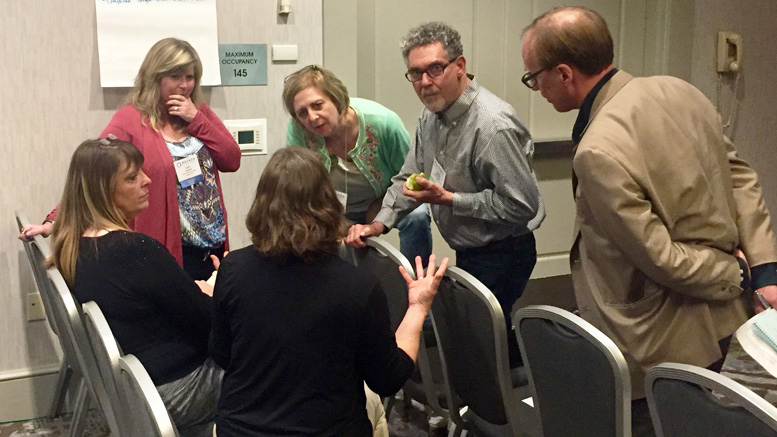The Voluntary Framework of Accountability (VFA), a data system developed by the American Association of Community Colleges (AACC), is helping participating colleges pinpoint areas where they excel and need to improve in order drive real change in improving student success.
College leaders interested in learning how to use the VFA to implement guided pathways and make institutional improvements are encouraged to attend a session at the AACC Annual Convention April 30 in Dallas. Presenters include: Kent Phillippe, associate vice president for research and success at AACC; Elizabeth Cox Brand, executive director of the Student Success Center at the Oregon Community College Association; and Vicki Martin, president of Milwaukee Area Technical College (MATC) in Wisconsin.
Now that the VFA has gained a national foothold, Phillippe says, community colleges are viewing it in a broader context to identify an institution’s strengths and challenges.
“As we’ve been fine-tuning the metrics and measures, the VFA’s value for internal assessment to guide institutional improvement has become more clear,” he says. The VFA now provides detailed data on students from the time they enroll to six years later, so colleges know how many credits they earn each year, whether they transfer or graduate, and much more.
“It’s less about comparing college A with college B than understanding how well college A is doing,” Phillippe says.
Convention schedule online: Check out the 2018 AACC Convention schedule to plan your days at the premiere community college event of the year.
The VFA data can be disaggregated many ways – by students’ racial and ethnic backgrounds; whether they are college ready or not; full time vs. part time; age; whether they are seeking a degree or other credentials; and whether they received a Pell Grant.
Colleges in AACC’s Pathways 2.0 initiative are using key performance indicators (KPIs) provided through the VFA to determine how many students on various pathways are earning six or 12 credits during their first term, how many pass college-level English or math the first year, and other outcomes. All VFA colleges will have access to KPIs in the current collection cycle.
Supporting pathways
The VFA data are a key part of the pathways work in Oregon. KPI data are used as a baseline that will be useful in tracking colleges’ progress as they implement pathways, Brand says.
All of the colleges in Oregon are participating in the VFA thanks to an agreement between AACC and the Oregon Higher Education Coordinating Commission, which is uploading the colleges’ data into the VFA system. “We’ve got some colleges that are so small they don’t even have an institutional researcher,” Brand says. “Getting good data is a challenge for them. Having them get good data through the VFA is terrific.”
Starting in May, the Oregon Student Success Center will offer training and support, with funding from Jobs for the Future, to five community colleges that are implementing guided pathways: Southwestern Oregon, Rogue, Lane, Chemeketa and Clackamas. Another cohort will start in May 2019.
Those colleges will focus on curriculum mapping, getting students on a pathway, keeping them on a pathway, and ensuring students are learning, Brand says.
The KPIs that tell colleges how many students are completing college-level math and English in their first year are critical. “That is a tough one. Many students tend to put those off. But if they complete those courses the first year, they will be much more successful in future courses,” Brand says.
As they track that data in subsequent years, colleges will be able to see what happens to students who completed those courses the first year compared to those who didn’t, Brand says. “The first step is awareness that it’s even an issue. That’s the ‘a-ha’ moment.”
First-year success
Having access to the VFA data “gave us a chance to see what areas we could really focus on,” Martin says, who notes MATC is in its first year in Pathways 2.0.
“We were surprised by some of our results,” Martin says. For example, she learned that only 7 percent of students completed college-level math and English their first year. So that is where MATC is focusing its energy.
By having detailed data on student demographics and how many students of various groups were able to complete six, 12 and 15 credits in the first semester and by having comparisons with other Pathways colleges, MATC leaders were able to gain insight on best practices and decide where to focus improvements.
As a result, the college adopted multiple measures to determine placement in math, implemented developmental math as a co-requisite, enhanced academic advising and started a men-of-color initiative. “We wanted to ensure students really understand the importance of taking college-level math in the first year,” Martin says.
Being in the VFA “really helped us prioritize,” she says. “It led to better conversations about why change is really important and necessary.”
New user training for the VFA: AACC is holding a series of training webinars for community colleges that have recently signed on to use its Voluntary Framework of Accountability. Is your college among the growing number of colleges using the VFA?

